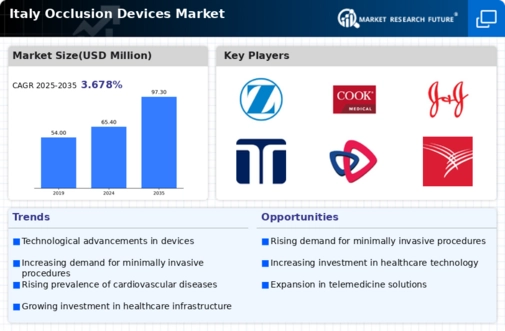Rising Healthcare Expenditure
The increase in healthcare expenditure in Italy is positively impacting the occlusion devices market. With the government and private sectors investing more in healthcare infrastructure and technology, there is a greater availability of advanced medical devices, including occlusion devices. In 2025, healthcare spending in Italy is projected to reach approximately €200 billion, reflecting a commitment to improving patient outcomes and enhancing surgical capabilities. This financial support is likely to facilitate the adoption of innovative occlusion devices, as hospitals and clinics seek to upgrade their surgical tools and techniques. As a result, the occlusion devices market is expected to benefit from this upward trend in healthcare investment.
Growing Awareness of Surgical Safety
There is a rising awareness of surgical safety among healthcare professionals and patients in Italy, which is contributing to the growth of the occlusion devices market. As surgical procedures become more complex, the emphasis on safety and efficacy has intensified. Medical institutions are increasingly adopting protocols that prioritize the use of reliable occlusion devices to minimize risks during surgeries. This heightened focus on patient safety is likely to drive demand for high-quality occlusion devices, as hospitals seek to comply with stringent safety standards. Consequently, the occlusion devices market is expected to expand as healthcare providers invest in devices that enhance surgical outcomes and reduce complications.
Technological Innovations in Medical Devices
Technological advancements in medical devices are significantly influencing the occlusion devices market in Italy. Innovations such as improved materials, enhanced delivery systems, and advanced imaging techniques are making occlusion devices more effective and user-friendly. For instance, the introduction of bioresorbable occlusion devices is gaining traction, as they offer the potential for reduced complications and improved patient outcomes. The Italian medical device industry is known for its focus on research and development, which is likely to foster further innovations in occlusion devices. This continuous evolution in technology is expected to drive market growth, as healthcare providers increasingly adopt state-of-the-art solutions to enhance surgical precision and efficiency.
Aging Population and Associated Health Issues
Italy's demographic landscape is characterized by an aging population, which is contributing to the growth of the occlusion devices market. As individuals age, they become more susceptible to various health conditions, including cardiovascular diseases and other disorders requiring surgical intervention. The Italian National Institute of Statistics indicates that by 2030, nearly 30% of the population will be over 65 years old. This demographic shift is expected to increase the demand for occlusion devices, as healthcare providers seek effective solutions to manage age-related health issues. Consequently, the occlusion devices market is likely to experience significant growth driven by the need for advanced medical technologies tailored to the elderly.
Increasing Demand for Minimally Invasive Procedures
The growing preference for minimally invasive surgical techniques is driving the occlusion devices market in Italy. Patients and healthcare providers are increasingly favoring procedures that reduce recovery time and minimize surgical trauma. This trend is reflected in the rising number of procedures utilizing occlusion devices, which are essential for achieving hemostasis and controlling bleeding during surgeries. According to recent data, the market for occlusion devices is projected to grow at a CAGR of approximately 7.5% over the next five years in Italy. This shift towards less invasive options is likely to enhance the adoption of occlusion devices, as they align with the evolving standards of patient care and surgical practices.

















Leave a Comment